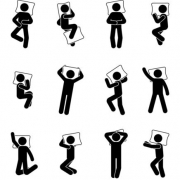Scoliosis: what positions to sleep in?
The determination of parents, and patients, to find ways of counteracting the progression of scoliosis often leads them to come up with questions, and to look for as many new strategies as they can.
One of the issues they raise concerns the awkward and “twisted” positions that children and adolescents tend to adopt when relaxing on the sofa or bed, or when they are writing, and so on.
Do these positions affect scoliosis in any way, and can they even cause it?
To answer these questions, let’s start by making a few key points clear. First of all, scoliosis is a disorder that causes deviation of the spine in the three dimensions of space, and it shows a natural progression; in most cases, it first appears in the early phases of growth. Posture, like the positions a person assumes in daily life, may affect the condition, but only to an extent, and they do not trigger or cause it.
This deviation of the spine, which throws it out of line, results in non-uniform loading of the spine and can therefore drive what is known as Stokes’s vicious cycle (asymmetrical loading causes asymmetrical growth leading to progression of the deformity…).
Conservative therapeutic approaches, consisting of specific self-correction exercises or brace wearing, aim to reduce this misalignment of the spine, counteracting the natural worsening of scoliosis and allowing more physiological growth of the anatomical structures of the spine.
When we are seated or standing, spinal loading is an important issue: in these positions, the force of gravity acts vertically on the whole of the spine, causing it to be more compressed and therefore more susceptible to developing an asymmetry.
Instead, when we are lying down, be it on our back, on our front or on our side, there is much less loading of the back, as the force of gravity is no longer pushing down on the spine, but distributed horizontally over the entire body.
During the night, precisely because we spend a number of hours lying in bed, with our backs unloaded and no longer subject to the stresses generated by loading and movements, our spine is able to “recover”: the discs situated between the vertebrae are rehydrated, and the entire spine lengthens.
You may well remember your parents remarking of a morning, “Goodness, you’re so tall! You seem to have grown overnight!” .
Well, as it happens, there is a physiological reason for this. Some studies suggest that we can gain up to 1-2 cm in height as an effect of these nocturnal regenerative phenomena. However, this extra height is lost in the course of the day, and with the passing of the years.
In conclusion, in the light of what has been said above, and also bearing in mind that we have no control over the positions we adopt when sleeping, our advice to patients is to carry on sleeping in the positions they find most comfortable, because there is no such thing as more or less correct positions during sleep.
Just make sure that the surface supporting your mattress (usually slats, metal bedsprings or a flat platform) ensures that it remains parallel with the ground, and that the central part does not sag. If you sleep in a brace, this isn’t even an issue, as your spine will remain correctly aligned whatever position you sleep in.
It is important to have an active lifestyle, do sport and, for those doing rehabilitation treatment, to follow the prescribed programme of physiotherapy exercises and/or brace wearing.
A final piece of advice: try not to spend too much time lying on your bed or on the sofa, unless it is to rest or watch something on TV!

